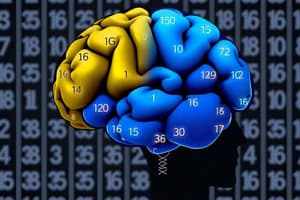Podcast
Questions and Answers
Which region of the brain is responsible for a variety of functions including receiving and processing sensory information, thinking, perceiving, producing and understanding language, and controlling motor function?
Which region of the brain is responsible for a variety of functions including receiving and processing sensory information, thinking, perceiving, producing and understanding language, and controlling motor function?
- Brain Stem
- Midbrain
- Forebrain (correct)
- Hindbrain
Which division of the forebrain is responsible for emotions, motivation, memory, and learning?
Which division of the forebrain is responsible for emotions, motivation, memory, and learning?
- Brain Stem
- Diencephalon
- Telencephalon (correct)
- Basal Ganglia
In terms of brain anatomy, which system is more developed in mammals and especially humans compared to fish and reptiles?
In terms of brain anatomy, which system is more developed in mammals and especially humans compared to fish and reptiles?
- Brain Stem
- Basal Ganglia
- Cerebellum
- Limbic System (correct)
Which intellectual processes are generally referred to as cognition?
Which intellectual processes are generally referred to as cognition?
Which part of the brain is associated with emotion and memory functions?
Which part of the brain is associated with emotion and memory functions?
The nervous system enables us to receive, process, and respond to information from the environment. Which part of the brain comprises the thalamus and hypothalamus involved in this system?
The nervous system enables us to receive, process, and respond to information from the environment. Which part of the brain comprises the thalamus and hypothalamus involved in this system?
What is one potential limitation of the cognitive neuroscientific approach mentioned in the text?
What is one potential limitation of the cognitive neuroscientific approach mentioned in the text?
Which method is NOT listed as one of the techniques used in the cognitive neuroscientific approach mentioned in the text?
Which method is NOT listed as one of the techniques used in the cognitive neuroscientific approach mentioned in the text?
What is a key advantage of using brain-imaging devices in cognitive neuroscience, according to the text?
What is a key advantage of using brain-imaging devices in cognitive neuroscience, according to the text?
Why are studies involving people with brain damages valuable, according to the text?
Why are studies involving people with brain damages valuable, according to the text?
Which of the following methods is specifically mentioned to involve studying 'live' cognitive functioning in healthy individuals?
Which of the following methods is specifically mentioned to involve studying 'live' cognitive functioning in healthy individuals?
Why might the cognitive neuroscientific approach struggle with high-order functioning, as per the text?
Why might the cognitive neuroscientific approach struggle with high-order functioning, as per the text?
What does higher intelligence correlate with in terms of brain metabolism during problem-solving tasks?
What does higher intelligence correlate with in terms of brain metabolism during problem-solving tasks?
Which brain region is highlighted as crucial for performance on general and fluid intelligence tasks?
Which brain region is highlighted as crucial for performance on general and fluid intelligence tasks?
How do smarter brains differ from less smart brains in terms of sugar consumption during tasks?
How do smarter brains differ from less smart brains in terms of sugar consumption during tasks?
What aspect of intelligence may not be indicated by performance on intelligence tests?
What aspect of intelligence may not be indicated by performance on intelligence tests?
Which brain theory stresses the importance of interconnected brain regions in determining differences in intelligence?
Which brain theory stresses the importance of interconnected brain regions in determining differences in intelligence?
Which brain region's lesions do people with high performance on standardized IQ tests often have?
Which brain region's lesions do people with high performance on standardized IQ tests often have?




